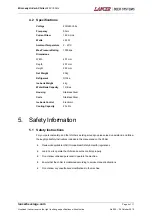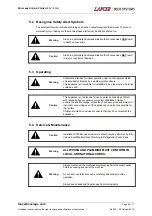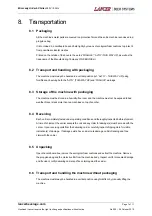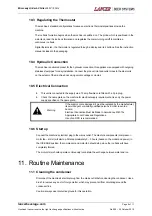
Mini Lady Hi-Carb Chiller
240V / 50Hz
lancerbeverage.com
Page 9 of 11
Hoshizaki Lancer reserve the right to change specifications without notice
No 005 – 26 October 2010
10.3 Regulating the Thermostat
The machine’s standard configurations foresee an electronic thermostat positioned inside the
machine.
The ice bank formation begins when the machine is switched on. The probe, which is positioned in the
water tank, read the ice bank formation and regulates the cooler turning on/off to maintain a
continuous ice bank.
Digital thermostat – the thermostat is regulated through a display and its 4 buttons. See the instruction
manual included in the packaging.
10.4 Hydraulic Connection
The machine is delivered preset for the hydraulic connection, this appliance is equipped with outgoing
stainless steel pipes for easy installation. Connect the product inlet and outlet pipes to the steel coils
on the exterior of the machine body using quick couplings or clamps.
10.5 Electrical Connection
This unit is connected to the supply via a 10 amp flexible cord fitted with a 3 pin plug.
Check the name plate on the machine for electrical supply requirements. Use only the power
supply specified on the name plate.
Warning
If the supply cord is damaged, it must be replaced by the manufacturer,
its service agent or similarly qualified persons in order to avoid a
hazard.
Electrical Connection Must Be Made In Accordance With The
Appropriate Local Codes and Regulations.
Use of an RCD is recommended.
10.6 Start up
Connect the machine’s electrical plug to the mains outlet. The machine components (compressor –
motor fan – stirrer) will start up. After approximately 3 – 5 hours (based on the model and power) in
the ICE BANK position, the compressor and motor fan should stop, since the ice bank will have
completely formed.
The motor stirrer should operate continuously to maintain the exchange between water and ice.
11. Routine Maintenance
11.1 Cleaning the condenser
Disconnect the machine’s electrical plug from the mains outlet before cleaning the condenser. Use a
brush to remove any dust or foreign matter, which may prevent air from circulating around the
condenser fins.
Caution: always wear protective gloves for this operation.





























